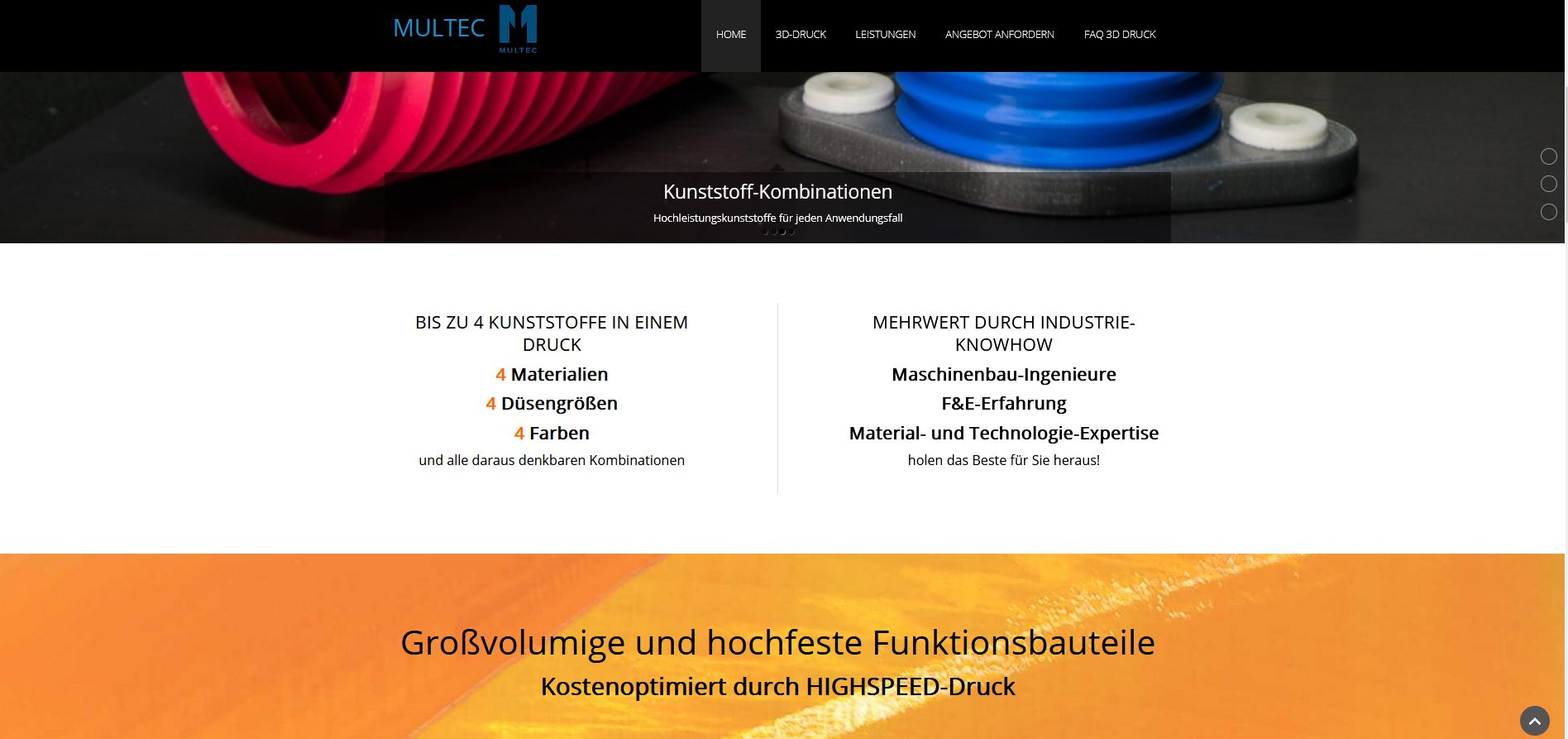Druckdienstleistung bei Multec

Hier können Sie Ihre Einstellungen nach Ihren Wünschen festlegen:
Diese Cookies sind notwendig, um das Surfen auf unserer Website und die Nutzung der Funktionen der Website, wie zum Beispiel den Zugriff auf geschützte Bereiche der Website, zu ermöglichen. Sie können diese Cookies in Ihren Browsereinstellungen deaktivieren. Bitte beachten Sie, dass dadurch die Funktionalität der Seite stark eingeschränkt wird.
Diese Cookies sammeln Informationen über das Surfverhalten der Besucher unserer Websites. Dadurch sind wir in der Lage, die Struktur, Navigation und den Inhalt der Website für Sie so benutzerfreundlich wie möglich zu gestalten.
Verfasst von Silvia Harder am .

Verfasst von Silvia Harder am .
Das Fachmagazin Ingenieur VDI berichtet ausführlich über Betriebsmittel-Fertigung mittels Metall 3D-Druck auf Multirap M4 Metal:
https://www.ingenieur.de/technik/fachbereiche/3d-druck/basf-und-zf-friedrichshafen-denken-bauteile-additiv-und-sparen-enorme-kosten
Beim Metall-Filament-Druck sind 90 % (Gewichtsprozent) Metallpulver in den Kunststoff eingebettet.
Gedruckt wird wie mit normalem Kunststoff-Filament, so wird das Metallpulver mit dem Binderpolymer in Form gebracht.
Das gedruckte Bauteil wird als „Grünling“ bezeichnet, durch anschließendes Sintern erhält das Druckteil Metallfestigkeiten.
Gutes Preis-Leistungs-Verhältnis
Geometrische Freiheitsgrade
Prototypen oder kleine Serien
Handling - Arbeitsschutz
Nachbearbeitung
Sinter-/Entbinderprozess
Ausführliches Dokument zum Metalldruck zum Download:
Darin finden Sie von konstruktiven Tipps und Hinweisen über das technologische Verfahren bis zu Druck-Parametern und Festigkeitswerten viele wertvolle Hinweise:
Das Dokument zum Download finden Sie hier.
Der dreidimensionale Druck hat die Arbeit in verschiedenen Branchen revolutioniert. Erste 3D Drucker arbeiteten allerdings mit einem reinen Kunststoff Filament, das sich nur schlecht oder gar nicht für den Einsatz in vielen technischen Bereichen eignet. Die Beimischung von Metall in ein Kunststoff Filament erlaubt nun auch den Metalldruck und vergrößert die Anwendungsmöglichkeiten des 3D Drucks damit signifikant. Erfahren Sie mehr zum 3D Druck mit Metall bei Multec.
Die Metall 3D Drucker unserer Multirap-Serie arbeiten mit verschiedenen Arten von 3D Druck Filament. Dieses liegt nicht in flüssiger Form vor, wie es bei der Tinte eines gewöhnlichen Tintenstrahldruckers der Fall ist. Vielmehr befindet sich das Filament auf einer Rolle, die in den 3D Drucker eingesetzt wird und den Druckkopf speist.
Das Filament ist in der Regel ein reines Kunststoffmaterial, das im Druckkopf geschmolzen und anschließend gemäß dem vorgegebenen Konstruktionsplan schichtweise zur Entstehung des dreidimensionalen Objektes aufgetragen wird.
Vom Grundprinzip ändert sich auch beim 3D Druck mit Metall nichts. Auch hier wird das Filament im Druckkopf also geschmolzen, um es anschließend verarbeiten zu können. Allerdings wird beim 3D Druck mit Metall nicht das Metall selbst geschmolzen. Das Filament besteht zu 90 Gewichtsprozent aus Metallpulver, der Rest ist das sogenannte Binderpolymer. Der 3D Drucker für Metall muss also nicht die hohen, für die Metallschmelze notwendigen Temperaturen erreichen. Die entstehenden, dreidimensionalen Objekte weisen allerdings nach Fertigstellung eine anders nicht erreichbare Festigkeit und ein deutlich höheres Gewicht auf. Um metallspezifische Eigenschaften zu erhalten, sind nach dem Druck das Entbindern und das Sintern als zusätzliche Arbeitsschritte erforderlich.
Nein, das ist nicht notwendig. Die Multirap 3D Drucker von Multec sind mit Druckköpfen ausgestattet, die mit unterschiedlichen Arten von Filament gespeist werden können. Sie können den 3D Drucker Metall also problemlos auch für 3D Drucke aus klassischem Kunststoff-Filament verwenden. Es ist allerdings nicht möglich, Multi Material 3D Drucke mit Metall Filament durchzuführen. Wenn Sie zum Beispiel einen Gewinde 3D Druck eingelagert in einem Kunststoffobjekt durchführen wollen, gelingt dies auch im Multirap 3D Drucker nur in mehreren Arbeitsschritten. Denn das 3D Druck Gewinde muss, anders als die reinen Kunststoffteile, nach dem Druck noch weitere Fertigungsschritte durchlaufen.
Wie bereits beschrieben, besteht das Filament für den 3D Druck mit Metall nach wie vor zu 10% aus einem Binderpolymer. Das dreidimensional ausgedruckte Objekt ist demnach nur zu 90% metallisch. Für viele Einsatzbereiche ist der gedruckte, sogenannte Grünling aber nicht geeignet, sondern muss noch weitere Schritte durchlaufen.
Erst der anschließende Prozess des Sinterns verleiht dem gedruckten Objekt die gewünschte Festigkeit. Ebenfalls abhängig vom Material wird das Objekt bei maximal 1.360 Grad gebrannt.
Wenn Sie einen 3D Drucker für Metall kaufen wollen, ist Multec Ihr kompetenter Ansprechpartner. Von uns bekommen Sie das Gerät und das für den 3D Druck mit Metall notwendige Filament. Da die Gerätschaften, die für das Entbindern und das Sintern notwendig sind, allerdings erst bei sehr hoher Auslastung rentabel sind, bieten wir diese Arbeitsschritte als Service für unsere Kunden an.
Haben Sie weitere Fragen? Dann können Sie uns gerne kontaktieren.
Diese Webseite verwendet Google Maps um Kartenmaterial einzubinden. Bitte beachten Sie dass hierbei Ihre persönlichen Daten erfasst und gesammelt werden können. Um die Google Maps Karte zu sehen, stimmen Sie bitte zu, dass diese vom Google-Server geladen wird. Weitere Informationen finden sie HIER